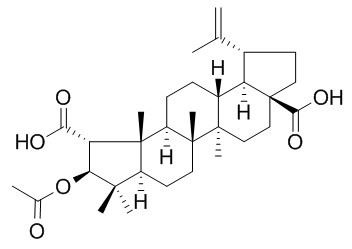Ceanothic acid acetate
Reference standards.
Inquire / Order:
manager@chemfaces.com
Technical Inquiries:
service@chemfaces.com
Tel:
+86-27-84237783
Fax:
+86-27-84254680
Address:
1 Building, No. 83, CheCheng Rd., Wuhan Economic and Technological Development Zone, Wuhan, Hubei 430056, PRC
Providing storage is as stated on the product vial and the vial is kept tightly sealed, the product can be stored for up to
24 months(2-8C).
Wherever possible, you should prepare and use solutions on the same day. However, if you need to make up stock solutions in advance, we recommend that you store the solution as aliquots in tightly sealed vials at -20C. Generally, these will be useable for up to two weeks. Before use, and prior to opening the vial we recommend that you allow your product to equilibrate to room temperature for at least 1 hour.
Need more advice on solubility, usage and handling? Please email to: service@chemfaces.com
The packaging of the product may have turned upside down during transportation, resulting in the natural compounds adhering to the neck or cap of the vial. take the vial out of its packaging and gently shake to let the compounds fall to the bottom of the vial. for liquid products, centrifuge at 200-500 RPM to gather the liquid at the bottom of the vial. try to avoid loss or contamination during handling.
Dicle Tip Dergisi2020, 47(2),423-430.
Applied Physics B2021, 127(92).
J Pharm Biomed Anal.2023, 234:115570.
Nutrients.2023, 15(24):5020.
Korean Journal of Pharmacognosy.2015, 46(4):352-364
Foods.2024, 13(19):3092.
Molecules.2018, 23(7):E1659
Protoplasma.2024, 261(6):1267-1280.
Vietnam J. Chemistry2022, 60(2):211-222
Mol Med Rep.2024, 29(2):26.
Related and Featured Products
Journal of the Chinese Chemical Society,1993, 40(2):213-216.
Microbial Transformation of Ceanothic Acid and Derivatives by Mycobacterium sp. (NRRL B-3805)[Reference:
WebLink]
METHODS AND RESULTS:
Ceanothic acid (1) is the major triterpene isolated from Parliurus ramosissitnus (Rhamnaceae) which possesses three methyl groups corresponding to the 4,4,14α-trimethyl groups in lanosterol (5). Microbial transformation of 1 and its 3-dehydro-2,28-dimethyl ester derivative (3) with Mycobacterium sp. (NRRL B-3805) resulted in the methylation of the carboxylic functions and C-1 epimerization, respectively.
CONCLUSIONS:
Although this work indicates that 1 is not a suitable substrate for 4,4,14α-tridemethylation, esterification of the carboxylic function and the C-1 epimerization reaction in ceanothic acid and its derivative is the first observation with this microorganism.



